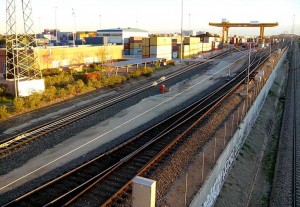The logistics sector needs to find new ways of transporting and managing freight to face needs dictated by economic contexts, such as now, where economic relocation is the norm, and where there is a trend towards greater limitation of stocks and continuously increasing demand from anywhere in the world. One of the solutions, boasting great results, is the dry port.
A dry port is an inland intermodal logistics terminal, directly connected by rail to a seaport and possible final destinations. In addition to obvious improvements to connections from inland locations to the coast within a country, it offers an advantage over terminals with similar features as customs offices can be set up within its enclosure, thereby streamlining paperwork and accelerating the transport process.
Dry ports give great optimisation of freight haulage as fast links with different modes of transport means orders can become more personalised. This depends on the characteristics of the cargo, the customer or the delivery. One of the key aspects of this type of terminal is its intermodal nature, as already mentioned in the blog, that consists of combining different modes of transport using the same cargo units (containers, swap-bodies or semi-trailers).
The intermodal aspect of dry ports improves management of transport resources and saves costs as it limits the workforce required for freight handling and haulage. In addition, this type of transport pre-seals all cargo units right up until the final destination making deliveries more secure, avoiding any possible losses or thefts.
Dry port in Pancorbo, Port of Bilbao terminal
The Port of Bilbao can boast many features that make it an attractive logistics centre for transporting goods. Its geographic position means that this dock is considered to be the gateway to sea traffic from America, also offering good connections with the Spanish and Portuguese mainland, France and the rest of Europe. In addition, its great capacity to house ships at all depths and its connections to other seaports have turned the Port of Bilbao into the transport powerhouse of the North of Spain.
To improve its service, since 2010 the Bilbao Port Authority has been developing a dry port that is envisaged to start operating next year. This 38 million Euro investment is taking shape in the town of Pancorbo (Burgos province), less than an hour from Bilbao.
Six years ago, the Bilbao local government bought 480,000m2 of land in the El Prado industrial estate, between the N-I main road and the AP1 Vitoria-Burgos-Madrid motorway. The Pancorbo Rail Logistics Terminal project (TELOF) receives European funding and it is being built by several executive technical units commissioned to build the rail connection and the service lines, in addition to developing the rail logistics terminal.
The first phase of the project will be up and running by the end of the year although the rail connections are already in place. This line is fitted with Spanish gauge railway tracks with the the possibility of migrating to international gauge to improve communications. The Rail Logistics Terminal has two loading and unloading lines, a reception/despatch track and a 30,000 m2 storage area that can be extended as the project goes on.
When the project is complete, the available surface area will total 500,000 m2, although the dry port will begin working with less than half its future capacity.


